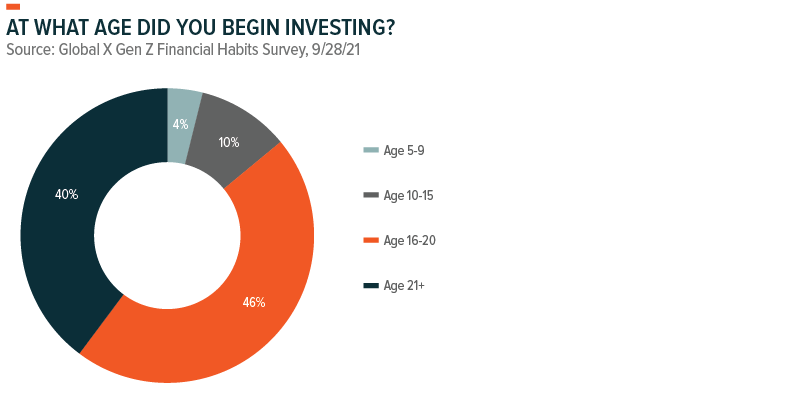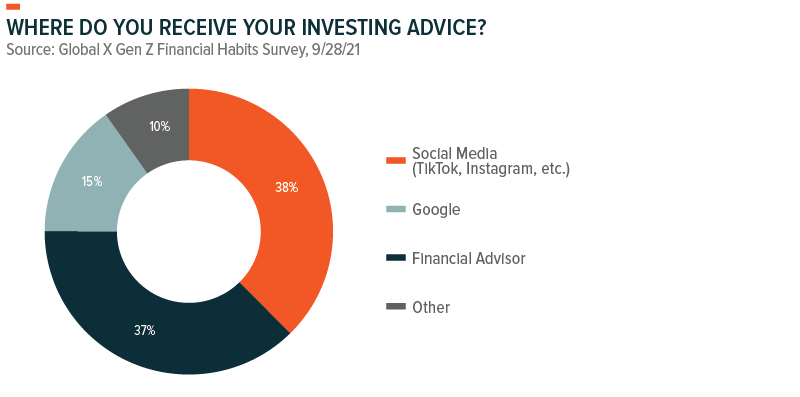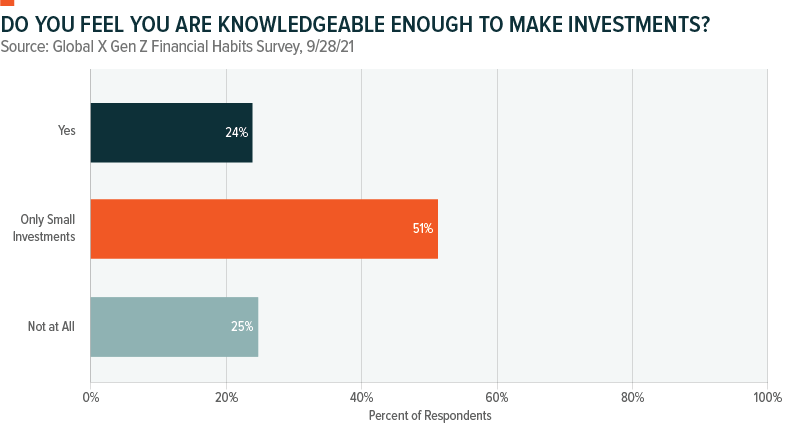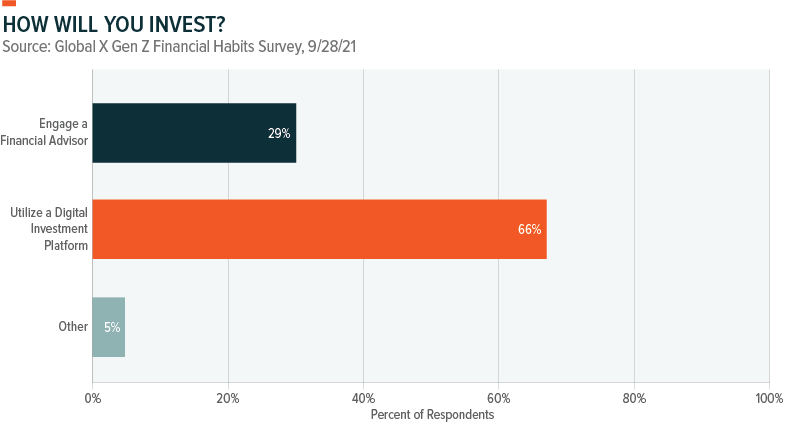Watch out world, Gen Z has arrived. In September 2021 we surveyed 513 U.S. Gen Z respondents to better understand the investing patterns of this demographic, which has come of age at time when all it takes to invest is the tap of a finger. Born between 1997 and 2012, these 9–24 year-olds are using their technological savvy and easy access to capital markets and digital assets to influence the investment landscape. Approximately 46% began investing between the ages of 16 and 20. Fifteen percent even said their first investments came between the ages of 5 and 15.
But with youth, there can be naiveté. Gen Z began investing in a largely up-market. As volatility increases, so too does the need for sound investment strategies, the best of which may not be found via social media. As this generation becomes a larger share of asset owners, it will be increasingly important for the investment community to consider how to engage with them.
Greater Market Access Has Positives and Negatives
Sixty-six percent of our survey participants use a digital investment platform, deftly toggling between investing apps and asset classes. While not explicitly revealed in the survey, the mere fact that all respondents answered the survey on a tablet or smartphone indicates their investing likely occurred on those devices.
The digitization of Wall Street makes investment platforms easier for investors to use; the content they read, listen to, and watch more available; and the fees that they pay to participate lower. But with increased participation comes more noise about what to invest in and why. According to our survey, Gen Z predominantly gets their investment advice from social media and Google. While these can be valuable sources of information, they also bring risks of following the crowd, particularly social media.
For some of these investors, the pandemic was their introduction to investing. More time on their hands in a socially distanced world, extra funds to spend, market access in the palm of their hands, and trending topics about assets going to the moon made it seem like investing is fun and easy. It’s only natural to focus on and be influenced by the success stories that they see on social media and the followings that these profiles can garner.
Yes, outsized bets on a single idea can result in a large payoff. But they can also result in significant losses quickly. Social media is excellent at generating buzz around a company or an idea. The latest meme stock craze certainly makes for a livelier comments section than reiterating the tried-and-true benefits of a well-rounded portfolio.
But what’s not glamorized is the failed idea or investors who jumped on a trade too late. It’s important to consider the risk profile of any investment and how it could impact the investor’s overall portfolio. In our view, information gleaned from sources like social media should be considered in conjunction with tools that can help reduce market concentration risk.
ETFs Can Be a Good Starting Point
Fifty-one percent of survey participants said that they felt comfortable making small investments, but 25% stated they were not knowledgeable enough to invest. It’s understandable, investing can be intimidating for anyone of any age without sound investment knowledge. But for those Gen Z’s looking to start, exchange-traded funds (ETFs) can help them increase their comfort level with investing and establish the foundation for a well-diversified portfolio.
The ETF is the financial instrument that truly democratized access to investing. ETFs provide easy, cost-effective access to diversification across companies, sectors, industries, and geographies, and they can be combined to form a balanced portfolio that reflects the investor’s beliefs. It’s these characteristics that make us believe that ETFs can help Gen Z investors become more comfortable making larger investments as they age into adulthood.
And with that foundation, there can still be room to complement the portfolio with exposure to assets making waves on social media:
- Meme stocks, cryptocurrencies, and other ideas that offer high risk and reward can be viewed as a part of the risk bucket within a broader portfolio.
- A sleeve of a diversified portfolio can be dedicated to long-term structural trends such as technological advancement and adoption, or demographics shifts.
- A large selection of ETFs incorporate different views on sustainability. Another approach involves dedicating a portion of a portfolio to technologies that assist sustainability.
For advisors, it’s important to recognize the asset trends that move the needle for Gen Z’s. One technique we use to bridge the gap in our work is Conversational Alpha, which can help put returns in a story-like context.
Gen Z Is FinTech Personified
Seventy-four percent of survey participants indicated they expect similar or more financial security than their parents. We believe that optimism is encouraging and speaks to the availability and ease of investing today, in many cases made possible by the proliferation of FinTech. Youth and ease don’t always translate to discretion, though. We believe the quality of investment advice, the method of implementation, and knowing what it means to invest for the long-term are key to a healthy financial future. Investing today is analogous to a video game, especially given the look and feel of trading platforms. But this video game comes with real risks.
Summary of Survey Results




 Michelle Cluver
Michelle Cluver